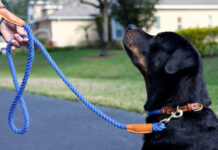Introducing your dog to a harness can be a game-changer in terms of comfort, safety, and control during walks or outdoor activities. However, getting your furry friend accustomed to wearing a dog harness might require a bit of patience and some strategic training. Understanding the importance of proper harness use and implementing effective training techniques can make the transition smooth and enjoyable for both you and your canine companion.
Choose the Right Harness:
Making the right dog harness choice is essential for your pet’s comfort. There are many different kinds of harnesses on the market, including no-pull, step-in, and vest harnesses. When selecting the appropriate fit, take your dog’s breed, size, and behavior into account. Make sure it’s just the right amount of snug to allow for freedom of movement without chafing or breathing restriction.
Familiarization:
Give your dog a positive, gentle introduction to the harness. Before trying to put the harness on, let your dog investigate and sniff it. By providing treats, praise, or playtime whenever your dog exhibits interest or comes near the harness voluntarily, you can help them associate the harness with good experiences.
Gradual Introduction:
Start by allowing your dog to get used to the dog harness in short increments. Begin by placing the harness near your dog during meal times or while engaging in activities they enjoy. Gradually progress by touching the harness to their body without fastening it, letting them get accustomed to the sensation.
Positive Reinforcement:
Associate the act of putting on the harness with positive experiences. Use treats or verbal praise when your dog allows you to put the harness on without resistance. Start by draping the harness over your dog’s back without securing it, rewarding calm behavior. Gradually progress to fastening the harness while offering encouragement and rewards.
Practice Makes Perfect:
Consistency is key in habituating your dog to the harness. Practice putting it on and taking it off multiple times a day in short sessions. Ensure that each session ends on a positive note, reinforcing the idea that wearing the harness leads to enjoyable experiences.
Distraction Techniques:
If your dog seems uncomfortable or resists wearing the dog harness, employ distraction techniques. Engage them in their favorite activities or offer a toy to redirect their attention while gently introducing the harness. Slowly transition by incorporating the harness into the activity, making it a natural part of their routine.
Patience and Calmness:
Maintain a patient and calm demeanor throughout the process of introducing the dog harness. Dogs can pick up on their owner’s emotions, so staying relaxed and positive will help reassure your pet and build trust. Avoid rushing or forcing the harness on your dog, as it may create negative associations.
Gradual Adjustment:
Once your dog is comfortable wearing the harness, allow them to wear it indoors for short periods. Monitor for any signs of discomfort or irritation, and make necessary adjustments to ensure a proper fit. Gradually increase the duration your dog wears the harness, making it a part of their daily routine.
Incorporate Harness with Walks:
Associate the harness with enjoyable activities, such as going for walks or outdoor adventures. Use the harness during fun and engaging activities to reinforce its positive association. Start with short walks, gradually increasing the duration while praising your dog for good behavior.
Check for Comfort and Fit:
Regularly check the harness for any signs of wear and ensure it remains properly fitted. Dogs may outgrow their harnesses or require adjustments due to changes in weight or muscle mass. A comfortable and well-fitted harness is essential for your dog’s safety and comfort.
Socialization with Other Dogs:
Once your dog is comfortable wearing the harness, introduce them to other dogs while wearing it. Positive interactions with other dogs while in the harness reinforce its association with enjoyable experiences.
Harness during Fun Activities:
Introduce the harness during activities your dog loves, like playtime or training sessions. Associating the harness with positive experiences beyond walks helps create a positive connection.
Seek Professional Help if Needed:
If your dog displays persistent aversion or fear towards the harness despite your efforts, seek guidance from a professional dog trainer or behaviorist. They can provide tailored strategies to help your dog overcome their discomfort.
Break it Down:
If your dog shows discomfort with the entire process, break it down into smaller steps. For instance, start by having your dog wear just the harness without fastening it. Gradually progress to clipping it on for short periods until they are comfortable with the complete process.
Conclusion:
Introducing your dog to a dog harness requires patience, positive reinforcement, and a gradual approach. By choosing the right harness, using positive training methods, and maintaining consistency, you can help your furry friend become comfortable and habitual with wearing a harness. Remember, the goal is to create a positive association between the dog harness and enjoyable experiences, making outings with your dog safe, comfortable, and enjoyable for both of you.
For more information, visit ApzoMedia



































































